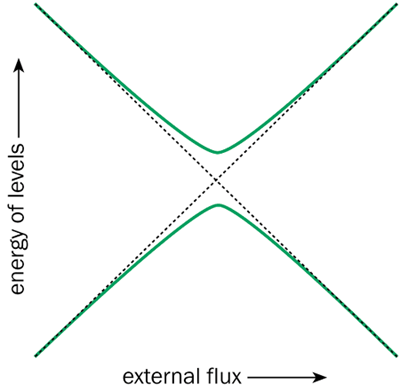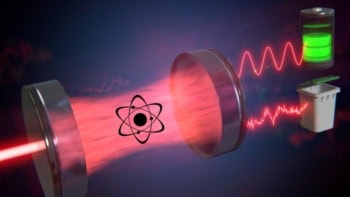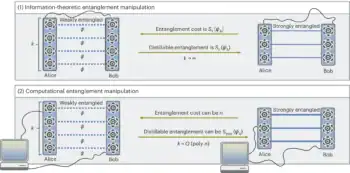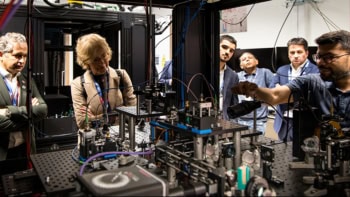The observation of quantum superpositions of distinct macroscopic states by groups at Stony Brook and Delft represents a milestone in experimental quantum physics. Both teams have reported spectroscopic evidence for currents of microamps flowing through a superconducting ring in opposite directions at the same time

When the formalism of quantum mechanics is applied to experiments involving microscopic objects such as electrons, we often find that the resulting description assigns finite probability amplitudes to two, or more, possibilities that appear to be mutually exclusive. In the classic Young’s double-slit experiment, for example, these possibilities are the passage of an electron through either the left- or right-hand slit.
According to most interpretations of quantum mechanics, we cannot say that any given electron goes through one slit or the other: to explain the interference patterns observed in double-slit experiments it appears that each electron must leave its options open until it is “observed”, at which point it always chooses one possibility (i.e. a particular slit) or the other.
As Schrödinger pointed out in a famous paper in 1935, this curious state of affairs cannot be quarantined at the atomic level. If we believe that quantum mechanics gives, in principle, a complete description of the physical world, then it is quite easy to set up a situation in which the formalism assigns a finite probability amplitude to each of two states that differ in dramatic ways. In Schrödinger’s “quite absurd” example, a cat is alive in one state and dead in the other. In such a situation we know that a measurement will reveal whether the cat is one state (e.g. alive) or the other (dead).
However, if we interpret the formalism of quantum mechanics in the same way as we do at the microscopic level, we could not say that the system (i.e. the cat) was in just one state before it was observed. Do we really believe this, or is the system in just one of the states, even in the absence of measurement? This latter scenario is called the “macrorealistic” scenario.
For many years it was widely believed that this rather fundamental question cannot, in principle, be answered. According to this view, by the time that the two states are “macroscopically” distinct, it will automatically be impossible to see the kind of quantum interference effects that are observed at the atomic level. The reason usually given for this assertion is the phenomenon of “decoherence”: the macroscopically distinct states of the system of interest (e.g. the cat) rapidly get correlated, it is claimed, to mutually orthogonal states of the “environment” (e.g. the radiation field). Once this decoherence happens, standard theorems of quantum mechanics assure us that no experiment on the system alone can show any quantum interference effects. In fact, all predictions made by quantum mechanics for such experiments are indistinguishable from those made using macrorealistic scenarios.
Which way round?
Over the last 20 years, however, it has gradually become accepted that this argument may fail in certain experimental systems. The key is to find a degree of freedom that can both generate macroscopically distinct states and also remain sufficiently decoupled from its environment.
Although several experimental systems have been explored, the most promising has been a device known as a superconducting quantum interference device or SQUID. This is a superconducting ring that contains one or more Josephson junctions, and the relevant variable is the current circulating in the ring (figure a).
Under appropriate conditions the potential energy of the system is a “double potential well” when plotted as a function of the current (figure b). The two states, the possible superposition of which we would like to investigate, are the ground states in the left and right well, respectively. One state corresponds to a current of about one microamp circulating in the clockwise direction, and the other corresponds to a similar current in the anticlockwise direction.
According to standard quantum mechanics, such a superposition would manifest itself as a coherent oscillation of these two currents. This oscillation could be observed directly in a so-called time-domain experiment. The superposition can also manifest itself as an energy difference or “splitting” between the two ground states that varies as a function of the bias applied to one well relative to the other (see figure c). The bias in these so-called spectroscopic experiments is in the form of an external magnetic flux through the superconducting ring.
Although there have been a number of experiments on related phenomena, such as quantum tunnelling out of a metastable well, up until very recently there was no reliable direct evidence for the superposition of macroscopically distinct states in a SQUID system.
Now experimental teams at the State University of New York at Stony Brook (J R Friedman et al. 2000 Nature 406 43) and the Technical University of Delft in the Netherlands (C van der Wal et al. 2000 Science submitted) have performed spectroscopic experiments and observed the variation of the energy splitting with external magnetic flux that is predicted by quantum mechanics.
The two experiments are similar in concept and design. The principal difference is that the Delft group observed the splitting of the ground state, as described above, whereas the Stony Brook team investigated a particular pair of excited states of the individual wells. In both cases, all the parameters necessary to calculate the quantum predictions were measured in independent experiments, and good agreement with these predictions was found.
While there has been much debate over the extent to which these two states are really “macroscopically” distinct, the Delft and Stony Brook experiments are very different from typical microscopic experiments in two respects. First, the circulating current in the two superposed states differs by an amount of the order of a microamp. This corresponds to a difference in magnetic moment of about 1010 Bohr magnetons: magnetic moments of a few Bohr magnetons are typical in experiments at the atomic level.
Second, we can ask how many electrons are behaving “appreciably differently” in the two states? Clearly the answer to this question depends on what is meant by appreciably different, but if we use the definition given by this author, the answer would seem to be in the range 109-1010 (A J Leggett 1980 Prog. Theor. Phys. Suppl. 80 p69). In both these respects the SQUID system appears, at present, to be unique among the candidate systems for demonstrating “macroscopic” superpositions.
What next?
Although the Delft and Stony Brook experiments, when interpreted according to the standard quantum formalism, give strong evidence for the existence of quantum superpositions of macroscopically distinct states, neither in their present form can definitively rule out the alternative hypothesis of macrorealism.
However, it should be possible to do this (or not!) in a time-domain experiment in which one measures a set of two time correlations of the current. This will be an important goal in the next generation of experiments. And then we shall know for sure whether Schrödinger’s cat has definitively expired or not before we look at it!





